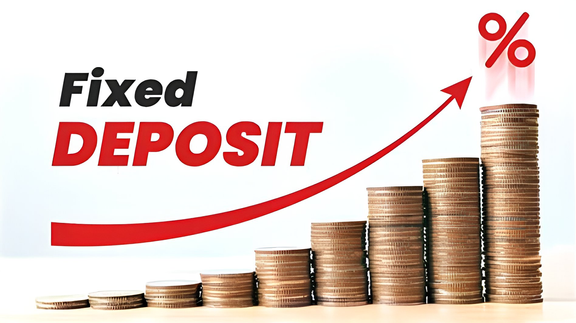In a rapidly evolving financial world where new investment avenues crop up every day, one instrument continues to dominate the hearts—and wallets—of Indian savers: the Fixed Deposit (FD). Despite offering modest returns, FDs have retained a loyal investor base across generations.
But why? In a country buzzing with fintech apps, crypto debates, and mutual fund SIP jingles, why do Indians still swear by FDs? Let’s explore.
The Indian Reality: A Culture of Safety and Certainty
India is a conservative savings-driven economy. Unlike Western economies, where credit and investment dominate financial behavior, Indian households prioritize capital protection over capital appreciation. According to the RBI’s “Handbook of Statistics on the Indian Economy,” over 50% of household financial assets in India are parked in bank deposits, with FDs forming a major share of this pool.
This preference isn’t just cultural—it’s rooted in trust, simplicity, and certainty.
FDs by the Numbers – A Giant Among Giants
As per RBI and industry estimates:
- Total bank term deposits stood at ₹204 lakh crore (~$2.45 trillion) by end of 2024.
- A whopping 60% of India’s household financial savings are parked in bank deposits, with FDs being the primary component.
- In FY2023-24 alone, term deposits grew by 18.5%, far outpacing growth in mutual fund and equity investments.
- Public sector banks alone saw ₹12.5 lakh crore in new term deposit inflows in 2023.
This data clearly shows that, despite increasing investment options, Indians continue to rely heavily on the predictability of FDs.
Why Indians Love FDs: Key Reasons
1. Guaranteed Returns
FDs promise a fixed interest rate for the tenure of the deposit—no market volatility, no surprises. This makes them ideal for people who prioritize capital protection.
2. Trust in the Banking System
Banks, especially public sector banks, enjoy a high level of trust among Indian savers. FDs are perceived as a bank-backed promise—safe, secure, and reliable.
3. Simplicity
- Open an FD online or offline in minutes.
- Choose the tenure, amount, and interest payout frequency.
- No need to monitor markets, NAVs, or price charts.
4. Flexible Tenure and Payout Options
- Tenure ranges from 7 days to 10 years.
- Choose between monthly, quarterly, or cumulative interest payouts.
- Option for auto-renewal, premature withdrawal (with penalty), or loan against FD.
5. Senior Citizen Benefits
Most banks offer an extra 0.25% to 0.5% interest to senior citizens. For retirees seeking predictable income, this makes FDs a lifeline.
6. Loan Against FD
In emergencies, you don’t need to break the FD. Banks offer 90% of FD value as loan, at interest rates lower than personal loans.
✅ Pros of Fixed Deposits
| Feature | Benefit |
|---|---|
| Capital protection | Principal is not affected by market risks |
| Fixed returns | Know exactly what you’ll get at maturity |
| Customizable tenure | From 7 days to 10 years |
| Regular income | Monthly/quarterly interest payout options |
| Easy access | Offered by all banks and post offices |
| Loan facility | Quick liquidity in emergencies |
⚠️ Cons of Fixed Deposits
| Concern | Explanation |
|---|---|
| Taxable interest | FD interest is fully taxable as per your income slab |
| Low returns | FD rates (typically 6–7.5%) may not beat inflation over the long term |
| Premature penalty | Breaking an FD early reduces interest and may involve penalties |
| Not inflation-indexed | Real returns can be lower if inflation rises sharply |
| Limited wealth creation | Not suitable for aggressive growth or long-term wealth building |
🔄 2025 FD Interest Rates Snapshot
| Bank | Regular FD Rate (5 years) | Senior Citizen Rate |
|---|---|---|
| SBI | 6.5% | 7.25% |
| HDFC Bank | 7.00% | 7.75% |
| ICICI Bank | 6.90% | 7.60% |
| Post Office | 7.5% | 7.5% (uniform rate) |
Rates as of April 2025 (subject to revision quarterly)
Recent Trends in FDs
- Private banks like Yes Bank, IDFC First Bank, and IndusInd Bank are offering rates up to 8.25% for specific tenures.
- Digital banks and NBFCs are promoting FDs through easy online KYC and slightly higher rates.
- Some banks now allow flexi-FDs—linked to your savings account—where excess funds automatically convert into FDs above a threshold.
Key takeaways
Smart investors always consider post-tax returns, use exemptions wisely, and review tax law changes every year to maximize wealth creation.
Tax inefficiency quietly erodes returns — many investors focus on gross returns without realizing how much tax eats into their actual gains.
Fixed Deposits, debt funds, and dividends are taxed at your income slab, often making them less lucrative for high-income investors.
New tax rules (especially post-2023) have changed the game for debt mutual funds and high-premium insurance policies, reducing their earlier tax benefits.
Lack of tax planning leads to avoidable losses, especially in capital gains from real estate, mutual funds, and stock investments.




